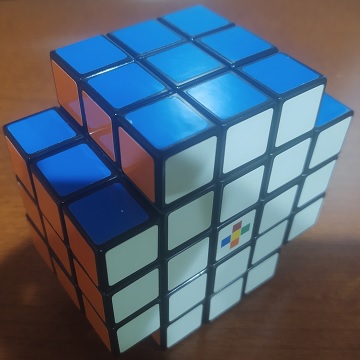

This cube is just like the 5x3x3, but instead of having just two extraneous 1x3x3 layers, it has four of them.
Just start with layer-solve using the white or yellow face as the base layer. Ignore the four 1x3x3 extraneous layers while restoring the shape of the puzzle (an "X"), as well as the 3x3 white and yellow faces in terms of color. The finaly layer is addressed next.
Reaching the final layer of layer-solve, you may notice an odd number of 1x1x2 edges flipped. The problem here is exactly the same problem you may encounter in Step 2 of the Fisher Cube. Use the same strategy to solve it.
Solve three of the four 1x3x3 extraneous layers. These are easy to put together.
For the finaly 1x3x3 extraneous layer, the edges may solve while the corners don't. Remedying this requires realizing that, just like the 5x3x3 cube, there is, let's say, "false freedom" in the placement of edges in the final layer of layer-solve. In Step 2 of my solution for the 5x3x3 cube, I called it an ambiguity, but in any case, you just need to realize that the four 1x1x2 edges can't be positioned in just any random way, though any such way solves the 3x3 face in terms of color and shape. Simply swap any two such edges in a re-solve of the final layer of layer-solve, then the final extraneous 1x3x3 layer will solve without difficulty. Of course, after such a swap, you may have to go back to Step 3, but once you get back to Step 4, you'll be able to complete the puzzle without trouble.
It's possible that an equivalent way to think about this problem is simply in the orientation of the center cubie of the 3x3 face of the final layer. It has 4 possible orientation, but only two of them will allow a solve. I have tested this, and it indeed appears to be the case. That being so, a much easier parity fix is to simply turn the finaly layer once (left or right), then resolve the extraneous 1x3x3 layers, but being careful as you do so that you do not change the parity of the center cubie.